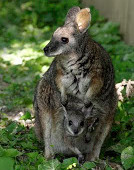Eucalyptus genome project on Science in Public
The genome of one of Australia’s biggest Eucalyptus trees, the Flooded Gum or Eucalyptus grandis, has now been mapped, allowing scientists and conservationists an insight into the secrets of an important piece of Australiana.Eucalyptus has become the most popular plantation tree in the world – with millions of hectares planted in Africa, America, Europe and… [Read More]
